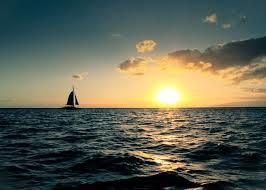The Inciting Incident and “the Call”
An extremely useful way to look at the Inciting Incident is to see it as “the Call,” as in the Hero’s Journey. The two are identical. They’re the same beat.

Setting sail for Tahiti. The inciting incident is the “Call to Adventure”
Here’s Christopher Vogler from his indispensable The Writer’s Journey:
The hero is presented with a problem, challenge, or adventure to undertake. Once presented with a Call of Adventure [boldface his], she can no longer remain indefinitely in the comfort of the Ordinary World.
In Star Wars, the Call to Adventure is Princess Leia’s desperate holographic message to wise old Obi-Wan Kenobi, who asks Luke to join in the quest. In revenge plots, the Call to Adventure is often a wrong, which must be set right. In romantic comedies, [it’s] the first encounter with the special but annoying someone the hero or heroine will be pursuing and sparring with.
See the parallels? In each case the Call is the Inciting Incident. It’s the action or event that sets the story in motion.
But let’s back up a moment to review the concept of the Hero’s Journey.
Two ways to look at it: first, the hero’s journey as a template for storytelling; second, the hero’s journey as a living dynamic in our real lives. Here’s what I wrote about the second way in Nobody Wants to Read Your Sh*t:
The hero’s journey is the Ur-Story of every individual from Adam and Eve to Ziggy Stardust. It’s the primal myth of the human race, the cosmic pattern that each of our lives follows (and a thousand increments thereof), whether we know it or not, whether we like it or not.
If you are the hero of your life (and of course you are), the hero’s journey is the script your life will (more or less) follow, over and over.
According to C.G. Jung, the hero’s journey is a component of the collective unconscious. Joseph Campbell identified it in the myths and legends of virtually every culture on earth. Jung found it arising spontaneously in the dreams and neuroses of his psychiatric patients.
The hero’s journey arose, both men speculated, from the accumulated experience of the human race over millions of years. The hero’s journey is like an operating system (or software in an operating system) that each of us receives at birth, hard-wired into our psyches, to help us navigate our passage through life.
The beats of the hero’s journey go something like this:
Hero starts in Ordinary World.
Hero receives Call to Adventure
Hero rejects Call
Hero encounters Mentor. Mentor gives Hero courage to accept call.
Hero crosses Threshold, enters Extraordinary World.
And so on through trials and ordeals, encounters with weird and wondrous characters, meetings with allies, confrontations with the Villain, finally to Crisis, Climax, and Resolution.
That’s the hero’s journey in our real lives. It’s us falling in love, quitting a job and launching a new venture, joining the CIA, setting sail for Tahiti, writing the Great American Novel.
Which brings us back to the first way of looking at the hero’s journey—as a template for writing a story/novel/screenplay. Star Wars is literally the hero’s journey. George Lucas patterned his script beat by beat upon Joseph Campbell’s template. So is The Wizard of Oz, Titanic, The Terminator, The Martian, When Harry Met Sally, and on and on.
In each case, that beat that you and I would call the Inciting Incident is, in terms of the hero’s journey, the Call to Adventure.
It’s the action or event that launches the hero out of the Ordinary World (also known as Act One) and into the Extraordinary World (Act Two and Act Three), the world of his or her initiation or passage into a deeper and more complete understanding of themselves and of life.
I know. I know what you’re thinking.
Why, you ask, does Steve keep beating this barely-breathing horse? Aren’t such considerations pure arcana? Technical stuff that we, unless we’re going for our Ph.D. in Literature, really don’t need to know?
No, no, and no.
I write just like you do, by the seat of my pants. I wing it. I trust the Muse. I come up with stuff and if it sounds good to me, I scribble it down.
In other words, I work out of my right brain.
But there comes a time (and that time should happen early early early) when you and I, if we’re smart, will and must switch over to our left brains.
We’ll engage our rational intellect.
We’ll take a cold, hard look at the mess we’ve just spewed across X hundred pages and we’ll ask ourselves, Is this stuff working? Is it a story? Will anybody want to read it?
At this point, we start asking ourselves the questions that every professional storyteller asks, among which are the following:
Do I have an Inciting Incident?
What is it?
How do I know it’s a legitimate inciting incident?
Does my hero acquire his or her intention in that moment?
Is the story’s climax embedded in that moment?
Is that moment on-theme?
And, from today …
Does that moment correspond to “the Call” in the hero’s journey?
I’m working on a novel right now and I am doing exactly this. I’m asking myself these exact questions (and many more).
It helps.
It’s critical.
It’s like standing on the deck of a sailboat in the middle of the Pacific, taking a reading of the stars with a sextant.
Trust me, if we omit these steps we will never make it to Tahiti.



